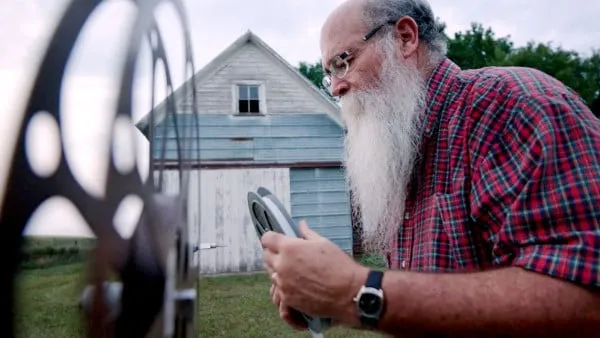Eye For Film >> Movies >> Saving Brinton (2017) Film Review
Saving Brinton
Reviewed by: Andrew Robertson

The Brintons, Frank and Indiana, were entrepeneurs, impresarios, founders of what is now the longest running cinema in the world. They believed in entertainment by mechanical means, magic lanterns, dissolving scenes, flying machines.
They had a collection. One that, through a chain of custody too complicated to explain, came to rest with Michael Zahs, "more storyteller than historian", which he (rightly) takes as a compliment. He will, in person, say that it's the film-makers who bear responsibility for the charm of Saving Brinton - Directors Tommy Harris, Andrew Sherburne, editor John Richard - but they have done so by capturing Zahs' overwhelming affability. I can say this with confidence because Eye For Film got to chat with him at Edinburgh's International Film Festival, his unexpected appearance at the Press & Industry screening a delight in a relatively dreary day. He even wore the same tie as he does on-screen, a present from his wife, with American Gothic upon it. It's not, and this will become understandable when you have see the film, a Christmas neck-tie. His gift, and it cannot be undersold, is charm. I saw him last in the Filmhouse chatting about projectors with festival staff and volunteers, and I hope that festival audiences also get to spend time with him. On screen this former teacher has a commanding presence, and I don't think I've ever seen a preview crowd so eager to shake someone's hand.

The Brinton collection was gifted to the University of Iowa - Washington, of that great state, is home to their cinema, still (still!) in operation. Zahs tours with archive, as the Brintons did before them - presentations made in schools, international festivals, in scenes that are delightful to the local Amish community. Travelling entertainments were vital to rural communities - I might be from Scotland's cinema city, but before the flicker of celluloid there was variety, the steady shuffle of sand-dancers from cinema to cinema, the same show from Blackpool to Bridlington, Dundee to Dalston. More options in metropolises though, not quite the same need to extract all the work from the kids before show-time. Which makes takings in the hundreds of 19th century dollars all the more striking. Despite that popularity, that presence, little survives.
Archeology is ephemera - we miss so much because everyone knew it, so nobody noted it - film is perhaps even more fragile. To borrow from Dana Schwartz, way back in 2015 (because Twitter allows me to), James Cameron's Avatar is the highest grossing movie of all time, but can you name two characters from it? Quote any line?
That's without acts of archival nightmare like George Melie's bonfire of nineteen and twenty three. With only the distance of the absence of 3-D Jake Sully and Grace Augustine have faded, but processes of colourisation are even more fragile. Yet the Brinton collection has treasures in it beyond catalogues and hand-bills, beyond advertisments for sandwiches under 25c. and projections that still work. There are films - films thought lost.
This is a film about a love of film, about the kind of people who save, who make do and mend - proper community participants, organising-committee-members, volunteer-lecturers, festival-liaisons, curator might be too strong but hoarder isn't kind enough - and all of them are Zahs.
The Brinton Entertainment Company's archive is held by Iowa University, it's available online but this is a film that rewards the cinephile in so many ways that your phone or laptop screen cannot hope to hold a candle or a magic lantern to it. This is a film that should be seen with an audience, on a screen big enough to capture the same magic that dazzled some century and a quarter ago.
There's a fresh composition for one of the films from the collection - the intent of the piece is "a little dreamlike on the edges and sometimes in the centre too" - so too this film. This is a film that opens in the Iowa snows, that makes its way through careful steps and public speeches and a moving eulogy and a meditation on euphemism and the fire-hardened nitrate vaults of film-archive and towers off piazzas and church bells and film dissolving and a succession of delights. It is magical, a trove. There might be something in the sense that this is less a collection - there are gaps - than a collation, and what is true of the Brinton archive is also true of Zahs. He self-effaces, praising "good sheds". Here Haines and Sherburnne and Richard have made something that is also warm, also dry, and full, stacked, with delight. This is something to save, and savour - see it if you can.
Reviewed on: 21 Jun 2018















